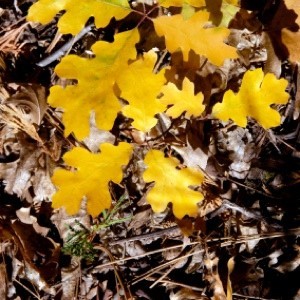
Every year in autumn, trees shower gardeners with an abundance of falling leaves and pine needles. To not take advantage of them in our gardens is to waste some valuable (and free) renewable resources. Here are some tips on how to use pine needles and leaves in your garden.
Changing the pH level of the soil can inhibit a plant's ability to absorb some nutrients, but tests have shown that leaves and pine needles can only create a very small change in the soil's pH when used as mulch or for winter protection. Whether or not these small changes will affect your plants depends a lot on your local climate conditions (how fast the leaves and pine needles decompose) and the pH of your existing soil.
If you use nothing but large amounts of leaves and pine needles over a period of several years, adding lime every few years will help counteract any acid buildup. Always let a soil test be your guide to making any adjustments. Fully composted leaves and pine needles are considered neutral and will not add to the acidity of your soil.
As a mulch. Because of their shape and rigidity, pine needles naturally lock together, which allows air and water to circulate while preventing the needles from packing down and forming a dense mat. This means your plants are far less likely to experience the rot and oxygen deprivation that sometimes occurs under thick layers of bark or leaves. The shape and rigidity of the needles also helps the mulch stay put during high winds and steady rains. Pine mulch can be used around vegetables and perennials of all kinds including roses and raspberries.
As winter protection. Add 3 to 5 inches of pine needle mulch to your garden beds in the fall. This will provide protection against sudden and extreme dips in temperature and allow plant roots to remain active until the ground freezes.
As a slug barrier. Create a ring of pine needles around the base of your hostas to help prevent slug damage. Pests like slugs and snails are known to avoid crawling over prickly objects that could injure or irritate their soft bodies.
As a walking path. Use pine needles to create walking paths between the rows in your vegetable garden. After you walk them a few times the needles pack down nicely. Not only do pine needles make an attractive path, but it will also help to keep the weeds from growing in-between your rows.
On your lawn. Run a mulching mower over them and let the leaves fall where they may. By chopping them up you'll be adding a thin layer of organic nutrients to your lawn, and you'll also save yourself some raking. If you don't have a mulching mower, simply raise the front wheels of your lawnmower by a notch or two and take several slow passes back and forth across your lawn. You can also put them in a tall plastic pail or garbage can and chop them up with your weed whacker.
To make leaf mold. Leaf mold is sometimes called garden gold and making it is simple. Collect leaves and drop them into a holding cage made from poultry wire wrapped around stakes pounded into the ground. If the leaves are dry when you collect them, wet them down with a hose. Now leave them there to decay. Next fall you can use your one-year-old leaf mold as a mulch, or allow it to decay for another year and use it to condition your soil.
As winter protection. Newly fallen leaves can be used as winter protection around plants, but need to be removed in spring to avoid smothering plants. Shredded leaves will decompose faster, but may also still need to be raked out in the spring. To prevent leaves from blowing away, cover them with pine branches.

About The Author: Ellen Brown is an environmental writer and photographer and the owner of Sustainable Media, an environmental media company that specializes in helping businesses and organizations promote eco-friendly products and services. Contact her on the web at http://www.sustainable-media.com
Add your voice! Click below to comment. ThriftyFun is powered by your wisdom!
I have used pine needles and leaves on my flower beds for several years. No ill effects noted, but do see it might be time to add some lime.
Thanks
It is better to avoid using the leaves of the walnut tree and the leaves of the trees from the same family the juglandaceae (butternut tree, hickory tree, and pecan tree) they produce juglone. The black walnut tree is the one with the highest production of juglone. Juglone is in the roots, the branches, the fruits and the leaves as well. Juglone is powerful enough to slow or stop the growth or kill many different flowers, trees, shrubs and vegetables which are sensitive to it.
Good tips. I make leaf mold and add it to my homemade potting soil and flower beds. If you don't have a holding cage, the leaves will still turn to leaf mold if kept in an out of the way pile. The bottom most layer will be usable, first.
Decomposed grass clippings are the best amendment I've found for lightning the soil. Do not use clippings treated with any herbicide.
Pine needle mold is possible especially when needles are green, damp, and deteriorating. Can cause an allergic reaction. It happened to me, lungs swelled up, along with shortness of breath. Not a mulch expert, but had good luck mixing pea gravel and compost materials together to airate soil.
Add your voice! Click below to comment. ThriftyFun is powered by your wisdom!